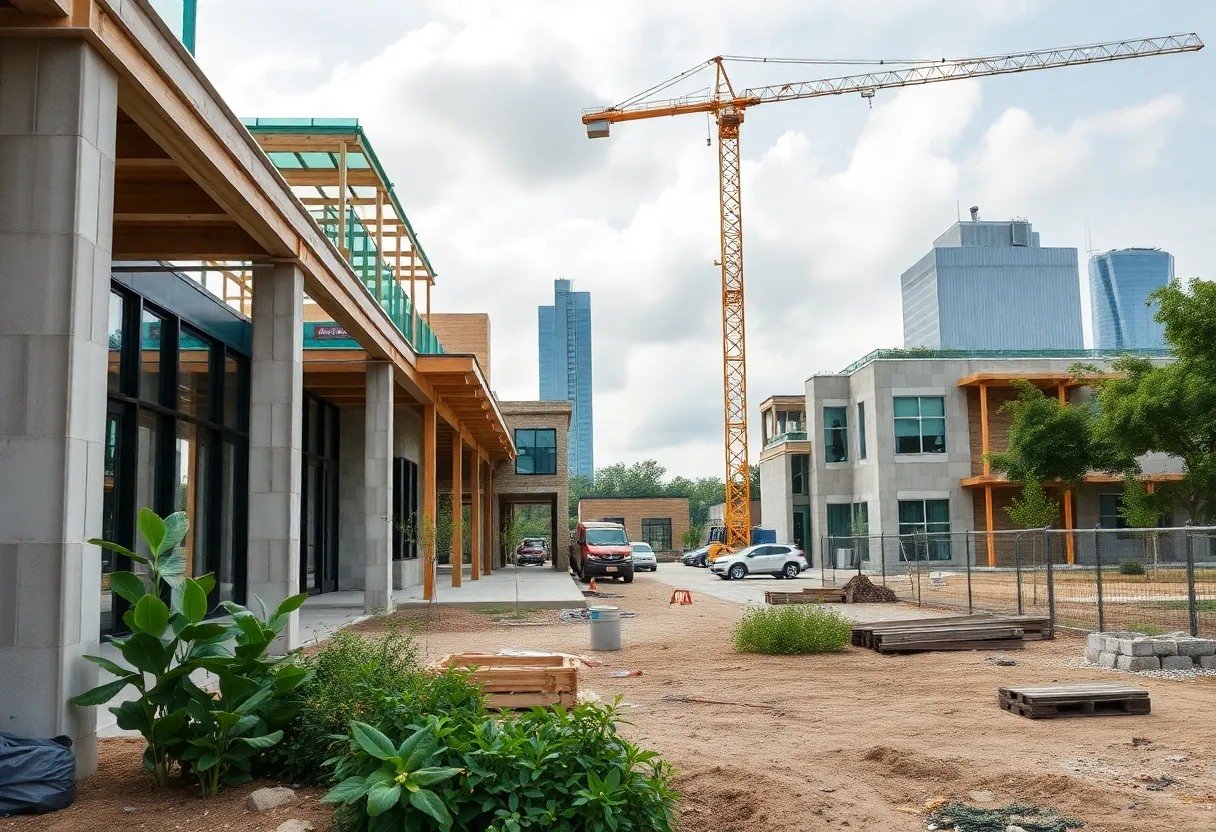What Are the Key Strategies for Choosing Sustainable Building Materials in Houston?
Houston’s construction industry is rapidly evolving, emphasizing sustainable practices to mitigate environmental impacts, conserve resources, and improve energy efficiency. Selecting the right building materials is foundational in this pursuit, demanding strategic approaches rooted in environmental responsibility, economic viability, and local adaptability. Implementing robust strategies ensures that projects meet both green standards and local building codes, fostering a resilient and eco-friendly urban landscape.
Prioritize Locally Sourced Materials
Locally sourcing materials significantly reduces transportation-related emissions, which are a major contributor to a project’s carbon footprint. Using regional resources like Texas-grown timber, local stone, and clay products supports the regional economy and minimizes energy expenditure associated with logistics. For example, opting for Houston-available reclaimed wood or native limestone not only aligns with sustainability goals but also enhances aesthetic integration with the local environment. Choosing local materials also ensures supply chain reliability and shorter lead times, ultimately reducing project delays and costs.
Select Renewable and Recycled Materials
Incorporating renewable materials such as bamboo, which regrows rapidly without heavy inputs, offsets the depletion of traditional hardwoods. Recycled materials like reclaimed wood, recycled steel, and repurposed glass reduce the demand for virgin resources and divert waste from landfills. These choices directly contribute to a circular economy in construction, minimizing environmental impact while maintaining structural integrity. Utilizing recycled content often qualifies projects for green building certifications, further validating eco-credentials.
Evaluate the Embodied Energy of Materials
Assessing embodied energy involves analyzing the total energy consumed throughout a material’s lifecycle—from extraction to manufacturing, transportation, installation, and disposal. Opting for materials with low embodied energy, such as recycled steel or natural fiber insulations, reduces overall carbon emissions and aligns with sustainability standards. This evaluation helps prioritize materials that contribute less to environmental degradation over their lifespan.
Ensure Durability and Longevity
Materials with high durability and longevity lower replacement frequency and maintenance costs, supporting sustainable building operation over time. Engineered wood products like cross-laminated timber exemplify this, offering high strength while being resource-efficient. Durable materials withstand severe weather conditions—crucial in Houston’s hot and humid climate—thus reducing long-term environmental impacts associated with repairs or replacements.
Consider Indoor Air Quality
Sustainable material selection must address indoor air quality. Using low or no volatile organic compounds (VOCs) in paints, adhesives, and finishes ensures healthier environments for occupants. This approach minimizes indoor pollution and enhances overall wellbeing, especially critical in commercial spaces, healthcare facilities, and residential buildings. Certification programs often stipulate low-VOC products, providing a clear guideline for compliance.
Incorporate Energy-Efficient Materials
Materials contributing to thermal resistance significantly enhance energy performance. Insulation options like cellulose, sheep’s wool, or cotton provide effective thermal barriers, reducing HVAC loads. These biodegradable insulations align with sustainability principles, decreasing reliance on energy-intensive mechanical systems and lowering greenhouse gas emissions.
Obtain Materials with Recognized Certifications
Certifications such as FSC (Forest Stewardship Council) for wood or LEED pre-approved materials serve as quality assurances of sustainable sourcing. Such credentials confirm adherence to environmental, social, and economic standards. Using certified products also facilitates meeting local and national green building requirements, earning points toward certification levels and increasing project marketability.
Implement Waste Reduction Strategies
Effective waste management involves on-site waste segregation, partnering with recycling facilities, and designing with pre-cut materials. Waste reduction not only minimizes landfill contributions but also improves resource utilization efficiency. Strategies such as modular construction and precise material estimating further reduce excess inventory and material wastage.
Engage with Suppliers and Manufacturers
Transparent communication with suppliers ensures access to eco-friendly products and detailed sustainability documentation. Building relationships with vendors committed to sustainable manufacturing fosters trust, secures consistent supply of green materials, and supports supply chain transparency. These collaborations help achieve regulatory compliance and green certification goals.
Stay Informed About Local Regulations and Incentives
Being aware of Houston’s regulatory landscape, including incentives and rebates, guides sustainable material choices. The city’s initiatives, such as reuse programs and material donation centers, facilitate sustainable sourcing. Complying with local building codes and leveraging incentives enriches project sustainability and financial feasibility.
Consider the Building’s Lifecycle
Holistic lifecycle analysis encompasses production, usage, and end-of-life management. Selecting materials that can be recycled or repurposed, or that cause minimal environmental harm during disposal, ensures a truly sustainable lifecycle. This approach supports urban resilience and resource conservation.
Incorporate Renewable Energy Systems
Integrating renewable energy, such as rooftop solar panels or wind turbines, complements the sustainability of building materials. This synergy reduces reliance on fossil fuels, lowers greenhouse emissions, and promotes energy independence. Design considerations should facilitate seamless integration of these systems for maximum efficiency.
Utilize Water-Efficient Materials
Choosing materials and fixtures that support water conservation enhances sustainability. Low-flow sealing systems, drought-resistant landscaping, and permeable pavements reduce water use and mitigate stormwater runoff. Such strategies are crucial in Houston’s climate, which demands resilient and water-efficient infrastructure.
Implement Green Building Certifications
Targeting standards such as LEED or BREEAM demonstrates commitment to sustainability. These certifications evaluate material selection, energy performance, water management, and indoor environmental quality. Achieving certification not only increases market competitiveness but also validates environmental responsibility.
Educate and Involve Stakeholders
Engaged stakeholders—including architects, contractors, clients, and community members—are vital for driving sustainable material choices. Regular communication, design charrettes, and educational workshops foster shared sustainability goals and ensure alignment throughout project phases.
Monitor and Optimize Performance
Post-occupancy assessment tracks energy consumption, water use, and indoor air quality. Utilizing smart technology helps identify inefficiencies and opportunities for improvement, ensuring operational sustainability matches initial intentions. Adaptive strategies enhance the building’s resilience and long-term performance.
Promote Community Engagement
Involving local communities in sustainable building projects fosters pride and acceptance. Community workshops, placemaking initiatives, and educational outreach ensure local insights influence material choices. Such engagement also encourages broader adoption of green practices in the region.
Plan for End-of-Life Recycling
Designing buildings for disassembly and material recycling minimizes waste generation at project decommissioning. Modular design and standardized components facilitate reuse of structural and finishing materials, supporting circular economy principles and resource conservation.
Assess Climate Resilience
Materials must withstand Houston’s humid, heat-prone environment. Moisture-resistant, thermal-efficient, and UV-stable materials reduce weather-related deterioration. Resilience reduces maintenance costs and extends building lifespan, vital in a climate characterized by extreme weather events.
Foster Innovation in Material Selection
Emerging sustainable materials—such as composite panels or bio-based products—offer performance benefits and lower environmental impacts. Encouraging innovative solutions accelerates the adoption of cutting-edge sustainability practices and enhances environmental benefits.
Implement Sustainable Landscaping Practices
Landscape design using native plants, rain gardens, and efficient irrigation reduces water dependency and supports local biodiversity. Sustainable landscaping enhances building sustainability and provides long-term ecological advantages.
Evaluate Cost-Benefit Analysis
Comprehensive financial assessments weigh initial costs against lifecycle benefits. Sustainable materials often incur higher upfront expenses but deliver long-term savings through reduced energy, water, and maintenance needs. Prioritizing cost-effectiveness encourages broader acceptance and implementation.
Stay Updated with Technological Advancements
Continuous research in green materials, smart building systems, and energy tech ensures the application of the most effective, innovative, and environmentally friendly options. Keeping abreast of technological trends ensures buildings remain at the forefront of sustainability.
Foster Collaboration Among Stakeholders
Cross-disciplinary teamwork ensures sustainability is embedded in every project phase. Collaboration among designers, engineers, contractors, and clients promotes shared responsibility and enhances sustainable outcomes.
Plan for Future Adaptability
Design buildings with flexible systems and materials that accommodate future upgrades and technological advancements. Adaptability ensures longevity and maintains relevance amid evolving sustainability standards and occupant needs.
Promote Education and Awareness
Regular training and information dissemination cultivate a sustainability-minded culture among professionals and community members. Educated stakeholders are better equipped to make informed decisions supporting green building practices.
Implement Sustainable Maintenance Practices
Eco-friendly cleaning, ongoing system optimization, and material preservation extend the building’s sustainable lifetime. Maintenance strategies should leverage sustainable products and practices to uphold environmental standards.
Monitor Regulatory Changes
Tracking evolving regulations and incentives ensures compliance and identifies opportunities for financial or operational benefits. Proactive adaptation maintains project competitiveness and sustainability integrity.
Evaluate Social Impacts
Material choices influence community wellbeing, labor practices, and social equity. Prioritizing ethically sourced and socially responsible materials increases positive social impacts, aligning building projects with broader sustainability goals.
Detailed FAQ Section
What are the top considerations when selecting sustainable building materials in Houston?
Key considerations include local sourcing, low embodied energy, durability, indoor air quality, certification standards, and climate resilience tailored to Houston’s environment.
How does local sourcing benefit sustainability in Houston?
Local sourcing reduces transportation emissions, supports regional economies, ensures availability, and aligns with Houston’s environmental and community goals.
Which certifications should I look for in sustainable building materials?
Look for FSC (Forest Stewardship Council), LEED compliance, BREEAM, WELL, and other recognized standards that validate sustainable and ethical sourcing.
What role does lifecycle analysis play in material selection?
Lifecycle analysis helps determine the long-term environmental impact, including extraction, manufacturing, use, and disposal, guiding informed sustainable choices.
How can I ensure that my project remains sustainable over time?
Regular monitoring of energy and water use, maintenance, and adapting to new technologies and standards are essential for ongoing sustainability.
Key Features of Sustainable Building Material Selection in Houston
| Feature | Description | Benefit |
|---|---|---|
| Local Sourcing | Materials acquired from regional suppliers within Houston or Texas. | Reduced transportation emissions; supports local economy. |
| Recycled Content | Materials like reclaimed wood, recycled steel, and glass. | Minimizes waste; conserves natural resources. |
| Certification Compliance | Standards like FSC, LEED, BREEAM. | Ensures ethical, sustainable sourcing. |
| Embodied Energy | Total energy involved in making and transporting materials. | Choice of low embodied energy materials reduces carbon footprint. |
| Durability | Resistance to wear, weather, and deterioration. | Fewer replacements; longer lifespan. |
| Indoor Air Quality | Low or no VOC emissions from materials. | Healthier indoor environments. |
| Climate Resilience | Materials resisting Houston’s heat, humidity, and storms. | Extended building longevity and reduced maintenance. |
Author: STAFF HERE HOUSTON TX WRITER
The HOUSTON STAFF WRITER represents the experienced team at HEREHouston.com, your go-to source for actionable local news and information in Houston, Harris County, and beyond. Specializing in "news you can use," we cover essential topics like product reviews for personal and business needs, local business directories, politics, real estate trends, neighborhood insights, and state news affecting the area—with deep expertise drawn from years of dedicated reporting and strong community input, including local press releases and business updates. We deliver top reporting on high-value events such as Houston Livestock Show and Rodeo, Art Car Parade, and Chevron Houston Marathon. Our coverage extends to key organizations like the Greater Houston Partnership and Houston Area Urban League, plus leading businesses in energy and healthcare that power the local economy such as ExxonMobil, Schlumberger, and Houston Methodist. As part of the broader HERE network, including HEREAustinTX.com, HERECollegeStation.com, HEREDallas.com, and HERESanAntonio.com, we provide comprehensive, credible insights into Texas's dynamic landscape.





